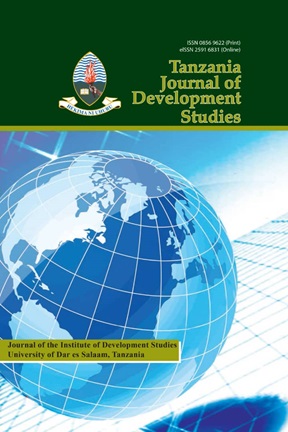Socio-demographic Determinants of Smallholder Farmers’ Adaptive Capacity to Climate Variability in Bukombe District, Tanzania.
Keywords:
Socio-demographic determinants, climate variability, smallholder farmer, adaptive capacity.Abstract
This paper examines the socio-demographic determinants of smallholder farmers’ adaptive capacity to climate variability in Bukombe district. It employed a mixed approach, utilizing both quantitative and qualitative methods. A simple random sampling selected 175 farmers for the study. The data collection methods included household surveys, observations, focus group discussions (FGDs), in-depth interviews, and document reviews. We conducted both descriptive and inferential statistical analyses using SPSS and Excel software. Ordinal logistic regression was adopted to determine the influences of socio-demographic determinants on farmers’ adaptive capacity. Qualitative data were subjected to content analysis. Rainfall and temperature data were analysed by using Microsoft Excel. The results indicated most of the smallholder farmers have low adaptive capacity to climate change. Furthermore, the findings reveal that socio-demographic factors of households—including age, gender, education, income, household size, and marital status—significantly influence smallholder farmers’ ability to adapt to climate variability; whereas land size and tenure do not significantly influence this capacity. Therefore, we recommend improving farmers’ adaptive capacity through sensitization and strengthening of household farming subsidies. We also recommend improving adaptive capacity by creating a more conducive environment, such as access to information, finance, seeds, and fertilizers. However, all initiatives should consider the demographic characteristics of farmers, as their adaptive capacity is dependent on the level and status of their household’s demographic characteristics.
Key terms: socio-demographic, determinants, climate variability, smallholder farmer, adaptive capacity.
https://dx.doi.org/10.56279/NJIY8787/TJDS.v22i2.2
References
Abaje, I. B., & Oladipo, E.O. (2019). Recent changes in the temperature and rainfall conditions Over Kaduna State, Nigeria. Ghana Journal of Geography, (11): 127-157.
Adger, W.N., Arnell, N.W & Tompkins, E.L.(2012). Successful adaptation to climate variability across scales. Global Environmental Change, 15(2): 77-86.
Agrawala, S., Moehder, A., Hemp,A., Van Aalst, M., Hitz, S. J., Meena, H., Mwakifamba, S., Hyera, T .& Mwaipopo, O.N. (2016). Development and Climate Change in Tanzania: Focus on Mount Kilimanjaro OECD, Paris. Agricultural sector: The case of Maluga and Chibelela villages, Central Tanzania. PhD thesis.
Alam, M.M., Siwar, C., Talib, B.A & Wahid, A.N. (2017). Climatic changes and vulnerability of Household food accessibility: a study on Malaysian east coast economic region. Int. J. Clim. Change Strategies Management, 10(2): 177-186.
Bello, M., Salau, A.S., Galadima, O.E & Ali, I. (2018). Knowledge, Perception and Adaptation Strategies to Climate Change among Farmers of Central State Nigeria. Global Environmental Change, 15(2): 77-86.
Cooper, P.M., Dimes, J., Rao, K.P., Shapiro, B., Shiferaw, B., & Twomlow, S. (2018). Coping better with current climatic variability in the rain-fed farming systems of sub-Saharan Africa: An essential first step in adapting to future climate change. Agriculture, Ecosystems and Environment, (126): 24-35.
Creswell, J.W.(2013). Research design: Qualitative, quantitative, and mixed methods approaches: SAGE Publications, Incorporated.
Dang, H., Elton,. Li, Nuberg, I., & Bruwer, J. (2019). Factors influencing the adaptation of farmers in response to climate change: A review, Climate and Development, 11(9): 765- 774.
Defiesta, G.,& Rapera, C.L. (2014). Measuring Adaptive Capacity of Farmers to Climate Change and Variability: Application of a Composite Index to an Agricultural Community in the Philippines. Journal of Environmental Science and Management, 17(2): 48-62.
Deressa, T.T., Hassan, R.M.,& Ringler, C. (2018). Perception and Adaptation to climate change and variability: The Case of Farmers in the Nile Basin of Ethiopia. The Journal of Agricultural Science, (149): 23-31.
Eakin, H., & Bojorquez-Tapia, L.A. (2018). Insights into the Composition of Household Vulnerability from Multicriteria. Decision Analysis. Global Environmental Change, (18): 112-127.
Eriksen, S.H., Brown, K., &Kelly, P.M. (2015). The Dynamics of Vulnerability: Locating Coping Strategies in Kenya and Tanzania. The Geographical Journal, 171(4): 287-305.
Frank, J., & Penrose, B.C. (2012). Small-scale farmers and climate variability: how can farmer organizations and Fairtrade build the adaptive capacity of smallholders? IIED, London.
Gbetibouo, G.A., Ringler, C., & Hassan, R. (2010). Vulnerability of the South African Farming Sector to Climate Change and Variability: An Indicator Approach. Natural Resources Forum, (34): 175-187.
Glewwe, P., & Gillette, H. (2017). Are some groups more vulnerable to macroeconomic shocks thanothers? Hypothesis tests based on panel data from Peru Policy Research Department, the World Bank and Washington, DC, USA b International Studies Program, University of Oregon.
Harvey, C.A. (2014). Extreme vulnerability of smallholder farmers to agricultural risks and climate variability in Madagascar. Philos. Trans. R. Soc, 20: 69 89.
Hellmuth, M.E., Moorhead, A., Thomson, M.C., & Williams, J.(2007).Climate Risk Management in Africa: Learning from Practice. International Research Institute for Climate and Society, Columbia University, New York.
Intergovernmental Panel on Climate Change (2018). Climate change impacts, adaptation and vulnerability. Contribution of Working Group II to the Third Assessment Report of the Intergovernmental Panel on Climate Change. Cambridge, United Kingdom and New York, United States, Cambridge University Press.
Kabote, S.J. (2018). Farmers ' vulnerability to climate variability impacts in semi-arid environments in Tanzania: A Gender Perspective. In: Arid Environments and Sustainability. Intech Open.
Kangalawe, R.M., & Lyimo, J.G. (2013). Climate change, adaptive strategies and rural livelihoods in semiarid Tanzania. Natural. Resource. 4: 266-278.
Kayunze, K.A.,(2020). Poverty disparities in small, large, male and female headed household in Rural Tanzania: a case study in Mbeya Region. Tanzania Journal of Population Studies and Development, 7(1): 1-16.
Kinuthia, K.J., Ino, S.K., & Nakhone, L. (2018). Factors influencing farmer ' s choice of crop production response strategies to climate change and variability in Narok East sub- county, Kenya. Journal of Natural Resource and Development, (8): 69-77.
Latha,A., Gopinath, M., & Bhat, A.(2016). Impact of climate change on rain fed Agriculture in India; A case study of Dharwad. Int. J. Environ. Sci. Dev, (3): 368 €“371.
Lindoso, D.P., Rocha, J.D., Debortoli, N., & Parente, I.C. (2012). Indicators for assessing the vulnerability of smallholder farming to climate change: The Case of Brazil, Semi-Arid Northeastern Region.
Menike, L., Arachchi, K.K. (2016). Adaptation to climate change by smallholder farmers in rural communities: evidence from Sri Lanka. Procedia Food Science, 6 (10): 288 €“292.
Mkonda, M.Y,& He, X. (2018). Climate variability and crop yields synergies in Tanzania ' s semiarid agroecological zone. Ecosystem Health and Sustainability, 4 (18): 59-72.
.
Morton, J.F. (2007). The impact of climate change on smallholder and subsistence agriculture. Proc. Natl. Acad. Sci. 104, 19680 €“19685.
Muema, E., Mburu, J., Coulibaly, J., & Mutune, J. (2018). Determinants of access and utilization
of seasonal climate information services among smallholder farmers in Makueni County,
Kenya. Heliyon, 4 (11):100-115.
Myeya, H.E. (2021). Recent temperature and rainfall characteristics in Dodoma Region, central Tanzania (1961 €“2013). Ghana Journal of Geography, (13): 63-80.
Paavola, J.(2014). Livelihoods, Vulnerability and Adaptation to Climate Change in Morogoro, Tanzania. Environmental Science and Policy, (11): 642-654.
Sarr, B.(2012). Present and future climate change in the semi-arid region of West Africa: A crucial input for practical adaptation in agriculture. Atmospheric Science Letters, 13(2): 108-112.
Sawe, J., Claude, G.M., & Godfrey, F.K. (2018).The impacts of climate change and variability on crop farming systems in Semi-Arid Central Tanzania: The case of Manyoni District in Singida Region African, Journal of Environmental Science and Technology, 12(9):232- 334.
Singh, C., Kituyi, E., & Urquhart, P. (2016). From pilots to systems: Barriers and enablers to scaling up the use of climate information services in smallholder farming communities. CARIAA Working Paper # 3. Collaborative adaptation research initiative in Africa and Asia, IDRC, Ottawa, Canada
Shikuku, K., Winowiecki, L., Twyman, J., Eitzinger, A., Perez, J.G., Mwongera, C.,&Läderach, P. (2017). Smallholder farmers ' attitudes and determinants of adaptation to climate risks in East Africa. Climatology and Risk Management, 13: 30 €“46.
Swai, E.Y., Njau, F., & Farrely, M. (2020). Enhancing the capacity of vulnerable community to climate change: Role of quality declared seed production model in semi-arid areas of Central Tanzania. In: Leal Filho W (Eds) Handbook of Climate Change Resilience. springer, Cham.
United Republic of Tanzania URT (2020).Basic data: Agriculture and cooperative sector statistics unit, planning and marketing division, Government Printer, Dar es Salaam.
Varela-Ortega, C., Esteve,P., Blanco, I., &Carmona, G.(2018). Assessment of socio-economic andclimate change effects on water Resources and agriculture in Southern and Eastern Mediterranean countries. MEDPRO Technical Paper No. 28/March 2018.
Westengen, O.T., & Brysting, A.K. ( 2014). Crop adaptation to climate change in the semi-arid zone in Tanzania: The role of genetic resources and seed systems. Agriculture and Food Security, 3: 1-12.
Yanda, P.Z., & Mubaya, C.P. (2011). Managing a Changing Climate in Africa: Local level Vulnerabilities and Adaptation Experiences. Mkuki na Nyota, Dar es Salaam. 190pp.
Ziervogel, G., Nyong, A., Osman, B., Conde, C., Cortés, S., & Downing, T. (2006). Climate Variability and Change: Implications for Household Food Security. AIACC Working P No. 20. International START Secretariat. Washington, District of Columbia.
Downloads
Published
Issue
Section
License
Copyright (c) 2025 Tanzania Journal of Development Studies

This work is licensed under a Creative Commons Attribution-NonCommercial-NoDerivatives 4.0 International License.
All internationally recognized general copyright standards apply.


